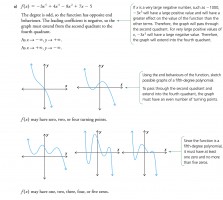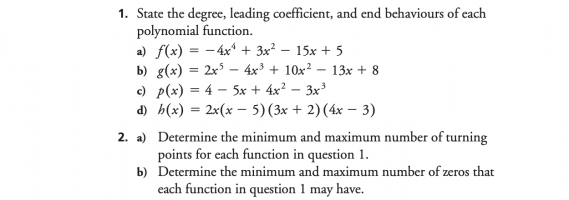Hi,
I'm having trouble understanding what exactly the min and max represent for polynomial functions by using the degree. The textbook doesn't really clarify this question for Advanced Functions....
For turning points and numbers of zeros, does min and max only mean those values. If you had an odd degree of 3 it has a min of 0 and a max of 2 TURNING POINTS (n-1). Does that exclude the ability for it to have only 1 turning point? And also for zeros, if an odd degree polynomial of 3 means a min of 1 and a max of 3 ZEROS, can it still have just 2 zeros or does it always have to be the set min and max values?
This question doesn't just apply for polynomials with a degree of 3, I just used that as an example. I don't understand if the min and max are set numbers or act as range (between). For zeross does it work as a range and for turning points is it just the minimum and maximum and nothing in between??
I'm having trouble understanding what exactly the min and max represent for polynomial functions by using the degree. The textbook doesn't really clarify this question for Advanced Functions....
For turning points and numbers of zeros, does min and max only mean those values. If you had an odd degree of 3 it has a min of 0 and a max of 2 TURNING POINTS (n-1). Does that exclude the ability for it to have only 1 turning point? And also for zeros, if an odd degree polynomial of 3 means a min of 1 and a max of 3 ZEROS, can it still have just 2 zeros or does it always have to be the set min and max values?
This question doesn't just apply for polynomials with a degree of 3, I just used that as an example. I don't understand if the min and max are set numbers or act as range (between). For zeross does it work as a range and for turning points is it just the minimum and maximum and nothing in between??


